Saturday, October 02, 2004
Billon antoninianus, Gallienus, Antioch, modern fakes of Göbl 1588b
(in which I am undone)
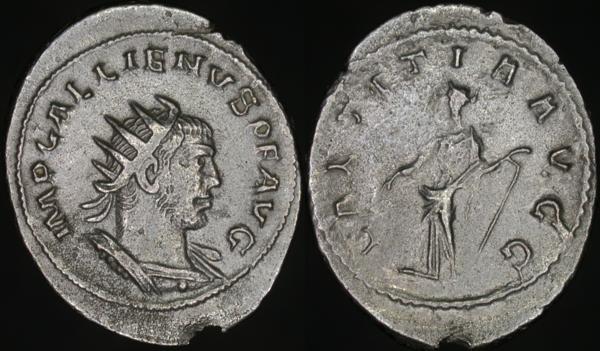
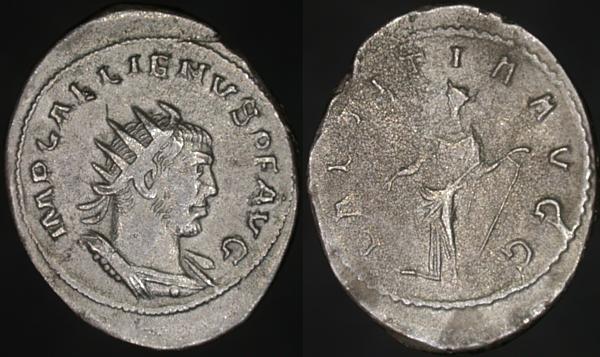
IMP GALLIENVS P F AVG, Radiate cuirassed bust right | LAETITIA AVGG, Laetitia standing facing, head left, holding wreath left, leaning on anchor right.
The vast majority of ancient coins that you see for sale are genuine, but forgeries do exist.
I didn't see anything wrong with either of these coins. I owned one of them for six months. It wasn't until I received the second, purchased from a different seller, that I became suspicious. Two ancient coins, made by hand, can't be this similar, with the same gouges and chipped edges.
Still in denial, I posted on the FORVM boards, and within minutes had my answer.
Somebody's going to the trouble of faking $40 coins. Since they're cast from a good original, they look convincing. And I needed to see two together to catch them.
Drat!


IMP GALLIENVS P F AVG, Radiate cuirassed bust right | LAETITIA AVGG, Laetitia standing facing, head left, holding wreath left, leaning on anchor right.
The vast majority of ancient coins that you see for sale are genuine, but forgeries do exist.
I didn't see anything wrong with either of these coins. I owned one of them for six months. It wasn't until I received the second, purchased from a different seller, that I became suspicious. Two ancient coins, made by hand, can't be this similar, with the same gouges and chipped edges.
Still in denial, I posted on the FORVM boards, and within minutes had my answer.
Somebody's going to the trouble of faking $40 coins. Since they're cast from a good original, they look convincing. And I needed to see two together to catch them.
Drat!
Friday, October 01, 2004
Æ25, Cius in Bithynia, Gallienus, Sear GIC 4540
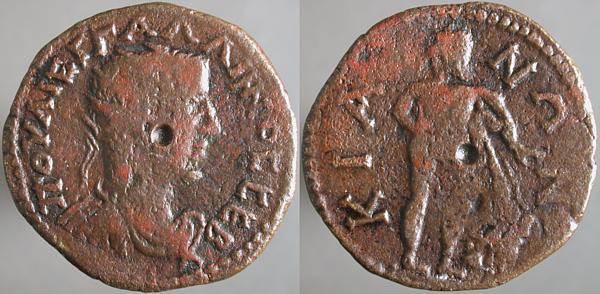
ΠΟΥ ΛΙ ΕΓ ΓΑΛΛΙΗΝΟC CΕΒ, Radiate draped cuirassed bust right | ΚΙΑ_ΝΩΝ, Herakles standing facing, head right, resting lion-skin draped club on rock at feet, right.
Interesting. As I started preparing this post, I realized that I'd seen these square C's before, at Nicaea, also in Bithynia. It may just have been a local style: the C-shaped "lunate sigma" was a popular third century replacement for the conventional sigma, Σ, but like S's that look like f's in the 18th century, they went out of style and are no longer used.
They may, though, indicate shared minting facilities, which wouldn't shock anyone, but it'd be interesting to prove. It'd take die links to provide that proof, and I don't see that yet, just an unusual letter form, and prominent centration marks.
Update: Darn, I see now I posted this before.
Thursday, September 30, 2004
Silvered Æ antoninianus, Gallienus, Cyzikus, Göbl 1547Ac
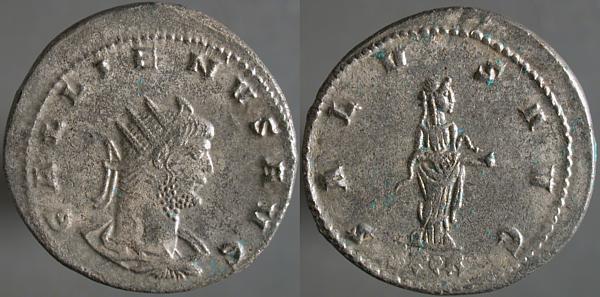
GALLIENVS AVG, Radiate draped cuirassed bust right, no pellets beneath | SALVS AVG, Salus standing facing, head right, holding snake in arms, feeding it from small patera right. SPQR in exergue.
I've previously posted a coin of Salonina from this mint, using this reverse. This is one of the few imperial issues of the reign that exists for both wife and husband.
The scene is a conventional depiction of Salus who, like the Greek Hygieia, represents health and is commonly portrayed feeding a snake.
Update 03/20/2005: fixed the link in the title
Wednesday, September 29, 2004
AR didrachm, Trajan, Caesaria in Cappadocia, SNG Cop 207
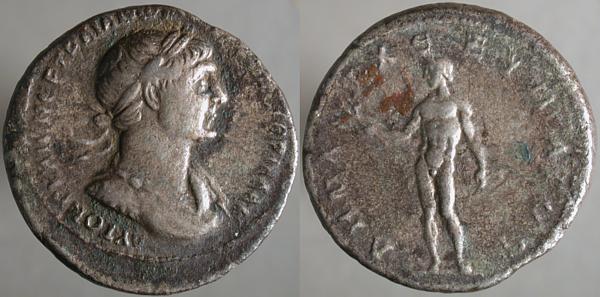
ΑΥΤΟΚΡ ΚΑΙC ΝΕΡ ΤΡΑΙΑΝΟC CΕΒΑCΤΟC, Laureate draped cuirassed bust right | ΔΗΜΑΡΧ ΕΞ ΥΠΑΤΟ S, Apollo standing facing, head left, holding branch left and bow right.
Marcus Ulpius Nerva Traianus was adopted by Nerva in the summer of 97 and became emperor upon Nerva's death January 27, 98.
There seem to be no scandals about Trajan, and he seems to have been as popular with his contemporaries as he was with Gibbon.
The last expansion of the Roman empire was during Trajan's reign, and, after Trajan's death in August, 117, his successor, Hadrian, would begin relinquishing small indefensible bits of territory.
The legend on the reverse says that it's the sixth year of Trajan's reign, so this was minted in 122 or 123.
Caesaria was the capital of Cappadocia. It became, for numismatists and coin collectors alike, a convenient default placename to assign to silver provincial coins with Greek legends and no cityname or "ethnic". These coins, like this one, have excellent portraiture which seems identical to that on the imperial coins minted at Rome.
Tuesday, September 28, 2004
Æ tetradrachm, Alexandria, Gallienus, Emmett 3728(4)
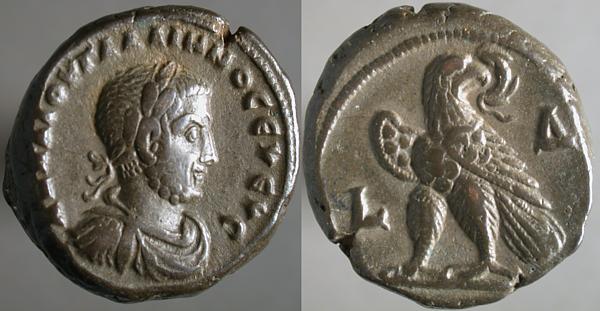
Α Κ Π ΛΙ ΟV ΓΑΛΛΙΗΝΟC ΕVΕVC, Laureate draped cuirassed bust right | L_Δ, Eagle standing left, head right, holding wreath. Regnal year across fields.
The second appearance here of the Anatolian god Mên, who first appeared here, with a few facts.
A very nicely-preserved coin from the fourth year of the joint reign of Gallienus and Valerian, as reckoned by the Alexandrian calender, 256-257 CE.
It sometimes seems against reason that something 17 centuries old should survive as intact as this but, once a coin has been lost in the dirt, or otherwise stopped circulating, if moist corrosive soil doesn't get it there's no reason it shouldn't survive until someone finds it.
Monday, September 27, 2004
Silvered Æ antoninianus, Gallienus, Cyzikus, Göbl 1535Ac
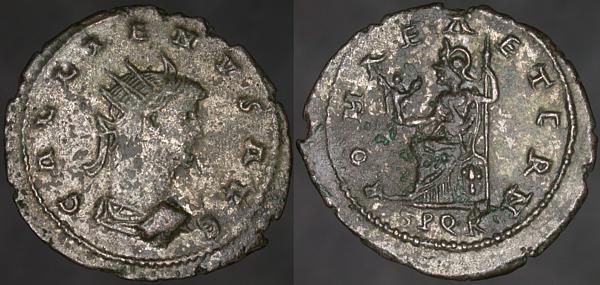
GALLIENVS AVG, Radiate draped cuirassed bust right, no pellets beneath | ROMAE AETERN, Roma seated left on gorgon-face shield, holding spear right and Victory presenting wreath left. SPQR in exergue.
Last month I posted a nicer example of this, but I've added this one to the collection since.
This is of interest because of the blob of metal in front of the Adam's Apple: the obverse die had cracked so badly that a piece of metal fell away, leaving a hole. If other coins can be found with this same blob, then I'll know that they were made with the same die, within a few days or weeks of this example. I won't even need to hold that coin, merely see a photograph, since the broken die is so distinctive, even if the coin is quite worn.
Since Göbl doesn't show any known die links for Gallienus from this mint, finding such a die link would be new knowledge, so I'd have that going for me. Which would be nice.
Sunday, September 26, 2004
Æ34, Sillyum in Pamphylia, Valerian II, SNG von Aulock 4891
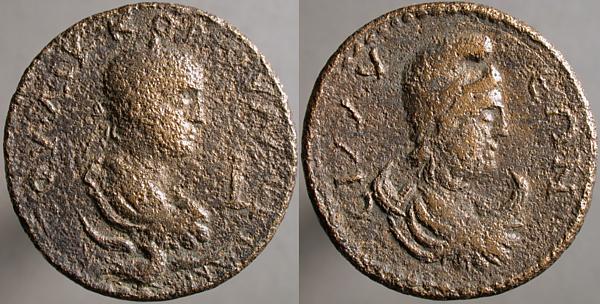
ΠΟV ΛΙΚ ΚΟΡ ΟVΑΛΕΡΙΑΝΟΝ, Laureate draped bust right, over eagle with wings spread, I before | CΙΛΛV_ΕΩΝ, Draped bust of Mên wearing Phrygian cap right, crescent on shoulders.
The second appearance here of the Anatolian god Mên, who first appeared here, with a few facts.
Valerian II was the older son of Gallienus (some older references have him the younger brother of Gallienus, but that seems to be an error), raised to the office of Caesar in 256. The cause of his death in 258 isn't certain.
I haven't found much on Sillyum, except that there's a hotel by that name in Belek, Turkey, which is at least in the general area.

